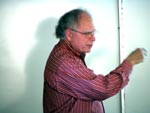Research Activities >
Programs >
Nonequilibrium Interface and Surface Dynamics 2007
|
|
Impurity-induced step patterns in vapor and
solution growth: From step bunches to Supersteps
CSIC Building (#406),
Seminar Room 4122.
Directions: home.cscamm.umd.edu/directions
|
Impurity-induced step patterns in vapor and solution
growth: From step bunches to Supersteps
Professor
John
Weeks

University of Maryland
|
Abstract:
Impurities that impede the motion of surface steps
typically produce step-bunching instabilities during
vapor growth, and reduce the growth rate. However
Land, et. al [1] showed that during solution growth
of KDP crystals impurities can induce dramatically
different behavior. In particular under appropriate
conditions, while single steps are blocked by
impurities, large coherent bunches of steps emerge
that can move much faster than single individual
steps. These "supersteps"
dominate the subsequent crystal growth.
We produce a new and general model of impurity
effects during crystal growth that can explain both
regimes. Essential features of model account for the
different mechanisms of mass transport during vapor
or solution growth, with the attachment rate at a
step in the latter case being essentially
independent of the terrace width in front, and the
effect of step repulsions, which can produce an
increased driving force on the first step in the
bunch. Good agreement with many features of the
experiments is found.
[1] T. N. Thomas,T. A. Land, W. H. Casey,and J. J.
DeYoreo, Phys. Rev.
Lett. 92, 216103/1-4 (2004)
[slides] |
|